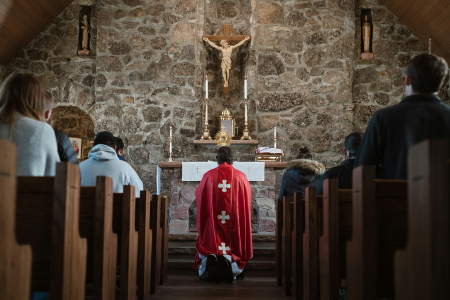Episcopal Gloves
FREE Catholic Classes
Liturgical gloves ( chirothecœ , called also at an earlier date manicœ , wanti ,) are a liturgical adornment reserved for bishops and cardinals. Other ecclesiastics, including abbots, cannot use them without a special papal privilege. They are worn only at a pontifical Mass, never at any other function, and then only to the washing of the hands before the Sacrifice. Episcopal gloves at the present day are knitted by machine or hand from silk thread, and are ornamented on the back with a cross; the border of the opening for the hand is also, as a rule, embellished. The colour of the gloves must correspond with the liturgical colour of the feast or day in the services of which they are worn; episcopal gloves, however, are never black, as they are not used on Good Friday nor at the celebration of Masses for the dead. When a bishop is consecrated the gloves are put on him by the consecrator, aided by the assisting bishops, just after the Blessing. The use of episcopal gloves became customary at Rome probably in the tenth century, outside of Rome they were employed somewhat earlier. Apparently they were first used in France, as the earliest traces of the custom are found in this country, whence it gradually spread into all other parts and even to Rome. The chief reason for the introduction of the usage was probably the desire to provide a suitable adornment for the hands of the bishop, rather than practical considerations such as the preservation of the cleanliness of the hands, etc. Episcopal gloves appertained originally to bishops, but at an early date their use was also granted to other ecclesiastics, thus no later than 1070 the abbot of the monastery of San Pietro in Cielo d'Oro at Pavia received this privilege, the first certain instance of such permission.
In the Middle Ages these gloves were either knitted or otherwise produced with the needle, or else they were made of woven material sewed together; the former way seems to have been the more usual. Gloves made by both methods are still in existence, as for example, in Saint-Sernin at Toulouse, at Brignoles, in S. Trinità at Florence, in the cathedrals of Halberstadt and Brixen, in New College at Oxford, Conflens in Savoy, and other places. In the later Middle Ages it became customary to enlarge the lower end, giving it the appearance of a cuff or gauntlet, and even to form the cuff with a long joint which hung downwards and was decorated with a tassel or little bell. The back of the glove was always ornamented, sometimes with an embroidered medallion or some other form of embroidery, sometimes with a metal disk having on it a representation of the Lamb of God, a cross, the Right Hand of God, saints, etc., the disk being sewn on to the glove, or, at times, the ornamentation was of pearls and precious stones. The gloves were generally made of silk thread or woven fabric, rarely of woollen thread, sometimes of linen woven material. Up to the end of the Middle Ages the usual colour was white, although the gloves at New College, Oxford, are red; apparently it was not until the sixteenth century that the ordinances as to liturgical colours were applied to episcopal gloves. Even in the Middle Ages the occasions on which the gloves were worn were not many, but their use was not so limited as today, for in the earlier period they were occasionally worn at the pontifical Mass after Communion, at solemn offices, and during processions. Episcopal gloves are symbolical of purity from sin, the performance of good works, and carefulness of procedure.
We ask you, humbly: don't scroll away.
Hi readers, it seems you use Catholic Online a lot; that's great! It's a little awkward to ask, but we need your help. If you have already donated, we sincerely thank you. We're not salespeople, but we depend on donations averaging $14.76 and fewer than 1% of readers give. If you donate just $5.00, the price of your coffee, Catholic Online School could keep thriving. Thank you.Help Now >
Join the Movement
When you sign up below, you don't just join an email list - you're joining an entire movement for Free world class Catholic education.
-

-
Mysteries of the Rosary
-
St. Faustina Kowalska
-
Litany of the Blessed Virgin Mary
-
Saint of the Day for Wednesday, Oct 4th, 2023
-
Popular Saints
-
St. Francis of Assisi
-
Bible
-
Female / Women Saints
-
7 Morning Prayers you need to get your day started with God
-
Litany of the Blessed Virgin Mary
U.S. Catholic Parishes Experience Resurgence of Traditional Practices
-

Pope Francis Urges Faith and Prayers for Peace
-

Florida Welcomes Volunteer Chaplains to Public Schools
-
10 Fascinating Details About St. Joseph the Worker: Celebrating His Feast Day - May 1
-
St. Joseph the Worker: Model for Men, Young and Old
Daily Catholic
 Daily Readings for Thursday, May 02, 2024
Daily Readings for Thursday, May 02, 2024 St. Athanasius: Saint of the Day for Thursday, May 02, 2024
St. Athanasius: Saint of the Day for Thursday, May 02, 2024 The Our Father: Prayer of the Day for Thursday, May 02, 2024
The Our Father: Prayer of the Day for Thursday, May 02, 2024- Daily Readings for Wednesday, May 01, 2024
- St. Marculf: Saint of the Day for Wednesday, May 01, 2024
- To Saint Peregrine: Prayer of the Day for Wednesday, May 01, 2024
![]()
Copyright 2024 Catholic Online. All materials contained on this site, whether written, audible or visual are the exclusive property of Catholic Online and are protected under U.S. and International copyright laws, © Copyright 2024 Catholic Online. Any unauthorized use, without prior written consent of Catholic Online is strictly forbidden and prohibited.
Catholic Online is a Project of Your Catholic Voice Foundation, a Not-for-Profit Corporation. Your Catholic Voice Foundation has been granted a recognition of tax exemption under Section 501(c)(3) of the Internal Revenue Code. Federal Tax Identification Number: 81-0596847. Your gift is tax-deductible as allowed by law.








 Daily Readings for Thursday, May 02, 2024
Daily Readings for Thursday, May 02, 2024 St. Athanasius: Saint of the Day for Thursday, May 02, 2024
St. Athanasius: Saint of the Day for Thursday, May 02, 2024 The Our Father: Prayer of the Day for Thursday, May 02, 2024
The Our Father: Prayer of the Day for Thursday, May 02, 2024

